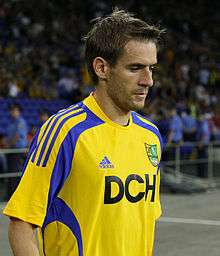Serbs in Ukraine
There is a community of Serbs in Ukraine (Ukrainian: Серби в Україні; Serbian: Срби у Украјини, romanized: Srbi u Ukrajini), which includes Ukrainian citizens of ethnic Serb descent or Serbian-born people residing in the country. According to the 2001 census, there were 623 citizens in Ukraine that declared Serb ethnicity. It is estimated that the community numbers ca. 1,000 (2012).
| Total population | |
|---|---|
| ca. 1,000 (see section) | |
| Languages | |
| Ukrainian, Russian, Serbian | |
| Religion | |
| Eastern Orthodox Church | |
| Related ethnic groups | |
| Serbs in Russia |
History
Russian Empire
Demographics
The 2001 census registered 623 citizens declaring Serb ethnicity (Національність: серби), out of whom 219 had Serbian citizenship, 104 Ukrainian, 218 Russian, 68 other.[1]
The Serbian Ministry of Diaspora estimated in 2007 that there was a Serbian diaspora community numbering ca. 15,000 people in Ukraine.[2] This data includes emigrants from Serbia as well as ethnic Serbs or other minorities who view Serbia as their nation-state.
In January 2012, it was estimated that the Serbian diaspora in the country only numbered 1,000.[3]
Notable people
.jpg) |  |  Marko Devich |
- John of Tobolsk, prominent Eastern Orthodox ascetic and hierarch of the Russian Orthodox Church of Serbian descent
- Yevgeny Vuchetich, prominent Soviet sculptor and artist of Serbian descent
- Milla Jovovich, Ukrainian-born American model, actress, musician, and fashion designer of Serbian descent
- Marko Devich, Serbian-born Ukrainian football player
- Vladimir Dišljenkovic, Serbian-Born Ukrainian football player
- Zlata Ognevich Singer
See also
| Part of a series of articles on |
| Serbs |
|---|
 |
|
Native communities
|
|
|
|
|
|
Related groups |
References
- "Всеукраїнський перепис населення 2001 | Результати | Національний склад населення, мовні ознаки, громадянство | Розподіл населення за національністю та рідною мовою | Результат вибору:". 2001.ukrcensus.gov.ua. Retrieved 2015-12-02.; "Ukraine Ethnic 2001".
- IOM (2008). "Migration in Serbia: A Country Profile 2008" (PDF). International Organisation for Migration: 24. Cite journal requires
|journal=(help) - "Дијаспора може да промени Србију". Politika.
Sources
- Cerović, Ljubivoje (2002). Срби у Украјини. Novi Sad: Muzej Vojvodine: Srpsko-ukrajinsko društvo. ISBN 86-82077-16-7. Archived from the original on 2014-01-11.
- Дмитрієв, В.С., 2006. Серби в Україні (XVIII-початок XIX ст.).
- Стрижок, О., 1993. Серби в Україні. Україна: наука і культура,-К, p.257.
- Дмитрієв, В.С., 2005. Сербські переселенці в Україні: проблема міжетнічних зв’язків. Вісник Національного університету імені Тараса Шевченка. Історія, pp.77-79.
